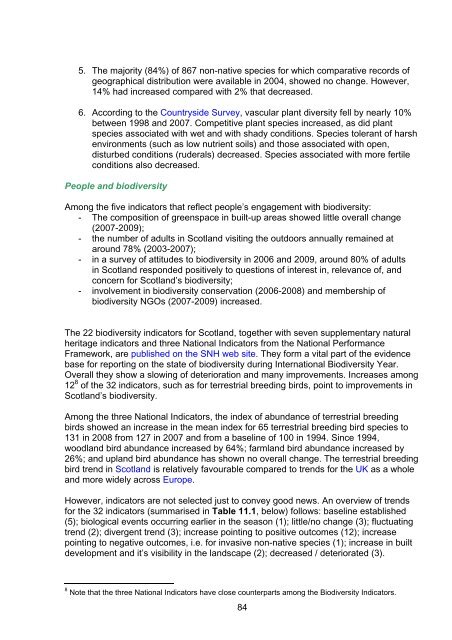Scotland's Wildlife â an assessment of biodiversity in 20
Scotland's Wildlife â an assessment of biodiversity in 20
Scotland's Wildlife â an assessment of biodiversity in 20
You also want an ePaper? Increase the reach of your titles
YUMPU automatically turns print PDFs into web optimized ePapers that Google loves.
5. The majority (84%) <strong>of</strong> 867 non-native species for which comparative records <strong>of</strong><br />
geographical distribution were available <strong>in</strong> <strong>20</strong>04, showed no ch<strong>an</strong>ge. However,<br />
14% had <strong>in</strong>creased compared with 2% that decreased.<br />
6. Accord<strong>in</strong>g to the Countryside Survey, vascular pl<strong>an</strong>t diversity fell by nearly 10%<br />
between 1998 <strong>an</strong>d <strong>20</strong>07. Competitive pl<strong>an</strong>t species <strong>in</strong>creased, as did pl<strong>an</strong>t<br />
species associated with wet <strong>an</strong>d with shady conditions. Species toler<strong>an</strong>t <strong>of</strong> harsh<br />
environments (such as low nutrient soils) <strong>an</strong>d those associated with open,<br />
disturbed conditions (ruderals) decreased. Species associated with more fertile<br />
conditions also decreased.<br />
People <strong>an</strong>d <strong>biodiversity</strong><br />
Among the five <strong>in</strong>dicators that reflect people’s engagement with <strong>biodiversity</strong>:<br />
- The composition <strong>of</strong> greenspace <strong>in</strong> built-up areas showed little overall ch<strong>an</strong>ge<br />
(<strong>20</strong>07-<strong>20</strong>09);<br />
- the number <strong>of</strong> adults <strong>in</strong> Scotl<strong>an</strong>d visit<strong>in</strong>g the outdoors <strong>an</strong>nually rema<strong>in</strong>ed at<br />
around 78% (<strong>20</strong>03-<strong>20</strong>07);<br />
- <strong>in</strong> a survey <strong>of</strong> attitudes to <strong>biodiversity</strong> <strong>in</strong> <strong>20</strong>06 <strong>an</strong>d <strong>20</strong>09, around 80% <strong>of</strong> adults<br />
<strong>in</strong> Scotl<strong>an</strong>d responded positively to questions <strong>of</strong> <strong>in</strong>terest <strong>in</strong>, relev<strong>an</strong>ce <strong>of</strong>, <strong>an</strong>d<br />
concern for Scotl<strong>an</strong>d’s <strong>biodiversity</strong>;<br />
- <strong>in</strong>volvement <strong>in</strong> <strong>biodiversity</strong> conservation (<strong>20</strong>06-<strong>20</strong>08) <strong>an</strong>d membership <strong>of</strong><br />
<strong>biodiversity</strong> NGOs (<strong>20</strong>07-<strong>20</strong>09) <strong>in</strong>creased.<br />
The 22 <strong>biodiversity</strong> <strong>in</strong>dicators for Scotl<strong>an</strong>d, together with seven supplementary natural<br />
heritage <strong>in</strong>dicators <strong>an</strong>d three National Indicators from the National Perform<strong>an</strong>ce<br />
Framework, are published on the SNH web site. They form a vital part <strong>of</strong> the evidence<br />
base for report<strong>in</strong>g on the state <strong>of</strong> <strong>biodiversity</strong> dur<strong>in</strong>g International Biodiversity Year.<br />
Overall they show a slow<strong>in</strong>g <strong>of</strong> deterioration <strong>an</strong>d m<strong>an</strong>y improvements. Increases among<br />
12 8 <strong>of</strong> the 32 <strong>in</strong>dicators, such as for terrestrial breed<strong>in</strong>g birds, po<strong>in</strong>t to improvements <strong>in</strong><br />
Scotl<strong>an</strong>d’s <strong>biodiversity</strong>.<br />
Among the three National Indicators, the <strong>in</strong>dex <strong>of</strong> abund<strong>an</strong>ce <strong>of</strong> terrestrial breed<strong>in</strong>g<br />
birds showed <strong>an</strong> <strong>in</strong>crease <strong>in</strong> the me<strong>an</strong> <strong>in</strong>dex for 65 terrestrial breed<strong>in</strong>g bird species to<br />
131 <strong>in</strong> <strong>20</strong>08 from 127 <strong>in</strong> <strong>20</strong>07 <strong>an</strong>d from a basel<strong>in</strong>e <strong>of</strong> 100 <strong>in</strong> 1994. S<strong>in</strong>ce 1994,<br />
woodl<strong>an</strong>d bird abund<strong>an</strong>ce <strong>in</strong>creased by 64%; farml<strong>an</strong>d bird abund<strong>an</strong>ce <strong>in</strong>creased by<br />
26%; <strong>an</strong>d upl<strong>an</strong>d bird abund<strong>an</strong>ce has shown no overall ch<strong>an</strong>ge. The terrestrial breed<strong>in</strong>g<br />
bird trend <strong>in</strong> Scotl<strong>an</strong>d is relatively favourable compared to trends for the UK as a whole<br />
<strong>an</strong>d more widely across Europe.<br />
However, <strong>in</strong>dicators are not selected just to convey good news. An overview <strong>of</strong> trends<br />
for the 32 <strong>in</strong>dicators (summarised <strong>in</strong> Table 11.1, below) follows: basel<strong>in</strong>e established<br />
(5); biological events occurr<strong>in</strong>g earlier <strong>in</strong> the season (1); little/no ch<strong>an</strong>ge (3); fluctuat<strong>in</strong>g<br />
trend (2); divergent trend (3); <strong>in</strong>crease po<strong>in</strong>t<strong>in</strong>g to positive outcomes (12); <strong>in</strong>crease<br />
po<strong>in</strong>t<strong>in</strong>g to negative outcomes, i.e. for <strong>in</strong>vasive non-native species (1); <strong>in</strong>crease <strong>in</strong> built<br />
development <strong>an</strong>d it’s visibility <strong>in</strong> the l<strong>an</strong>dscape (2); decreased / deteriorated (3).<br />
8 Note that the three National Indicators have close counterparts among the Biodiversity Indicators.<br />
84
















